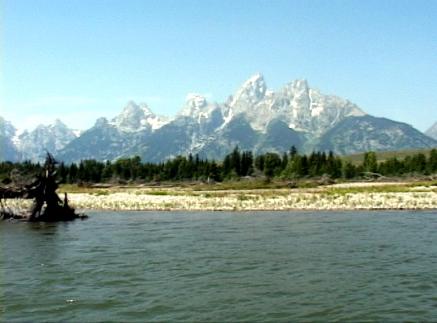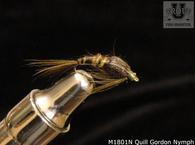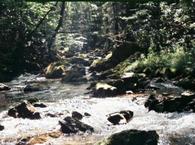
The headwaters of the Snake River are in the Southeastern portions of the Yellowstone National Park and have been included in the Yellowstone National Park section of the Trout University Streams. However, after leaving the Park, the Snake River runs through the Teton National Park to Jackson Lake. After leaving Jackson Lake it flows to the Palisades Reservoir and through the Bridger Teton National Forest. Some might say that this area is one of the most scenic areas of the entire United States.
As the Snake is in the Yellowstone National Park, so it is outside the Park inhabited with large cutthroat averaging from 12 to 16 inches with an occasional one running up to 20 inches. These cutthroats on the Snake are often vulnerable to large dry fly attractor patterns. The river itself provides plenty of good cover in braided channels, undercut banks and other excellent holding places that harbor magnificent cutthroat.
The section of the river, between the Yellowstone Park and Lake Jackson, increases in size as it picks up the water from the Lewis River. It is wide, with a moderate decline, a gravel bottom and banks lined with willows. The brown trout move out of Jackson Lake and make their way upriver to spawn with the cutthroat moving behind the browns.
The four mile section below the dam at Jackson Lake extending down to Pacific Creek is a popular section all year long and contains whitefish, lake trout and Cutthroat. This relatively smooth water can be fished by wading or by drift boat. After being joined by the water from Pacific Creek, the water on the eleven mile stretch down to Deadman's Bar can become cloudier especially after heavy rains. It also can become a more dangerous river to navigate and for that reason an experienced guide is recommended to enjoy the excellent fishing that is offered.
The eight mile section from Deadman's Bar to Moose is also a popular spot to fish and it can be waded but caution is the order of the day. The next fourteen miles down to Wilson Bridge can be floated by drift boat but again experience is required to take advantage of the excellent fishing. By being selective, however, fishing from the banks can be productive in some locations. The next thirteen miles down to highway 26/89 bridge continues to be a popular stretch as well.
The next eleven miles of river from the South Park takeout down to Astoria Springs flows through a canyon with the Hoback River joining the Snake right near Astoria Springs. The last section of the Snake River in the state of Wyoming runs from Astoria Springs to Palisades Lake and it drops in a very steep decline providing some great white water. This white water makes it extremely unlikely that you would fish it from a boat or raft. However, it can be fished from the banks in some locations.
Spring:
The spring runoff starts in May and extends into late July causing a mess, however before the runoff, there is a short period while the Snake can be fished. The blue winged olive hatches and the little black stonefly hatches provide the best opportunities during the early spring.
Summer:
The early part of summer is spoiled by the messy spring runoff but starting after the spring runfoff in mid to late July the Snake provides excellent fishing. Little yellow stoneflies will be hatching in some areas during late June and July followed by the golden stoneflies in August extending into September. Pale morning duns while not seen everywhere on the river will provide plentiful hatches in late August and September as well. Caddis flies will also be hatching from June thru September.
Fall:
The fall months until the end of October will provide a great time for fly fishing on the Snake River. Mahogany duns, drake mackerels, and October caddis as well as the second hatches of the blue winged olives will be effective patterns during this time.
Winter:
Closed Season
Easy access to the Snake River can be found departing from Jackson Hole, WY.
View Western USA in a larger map





